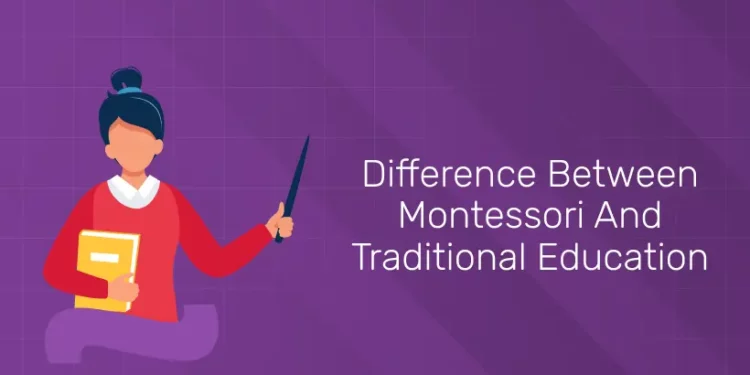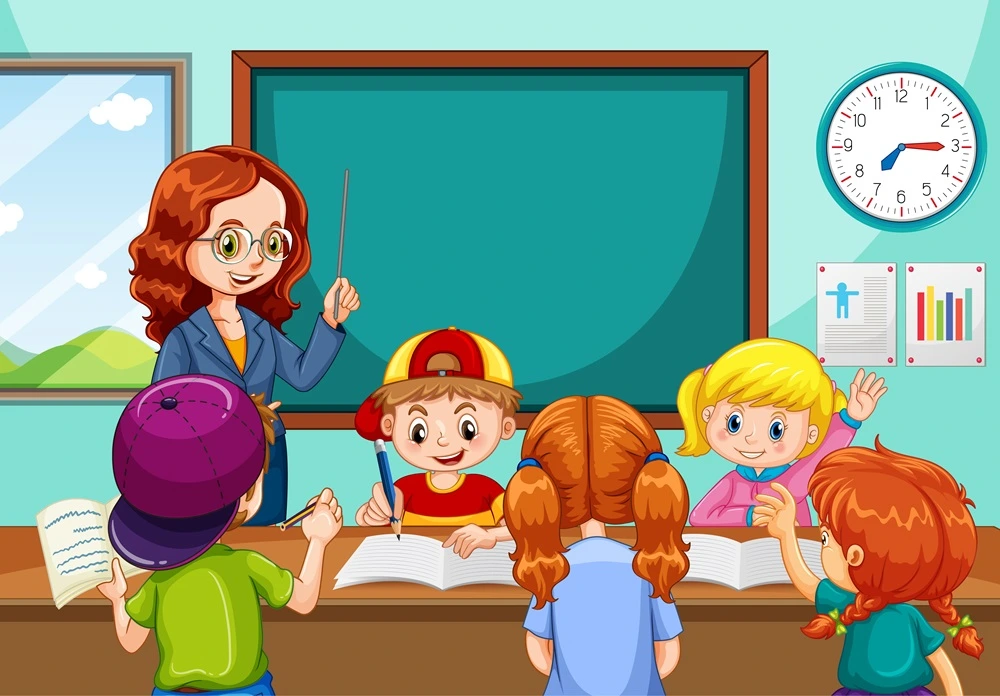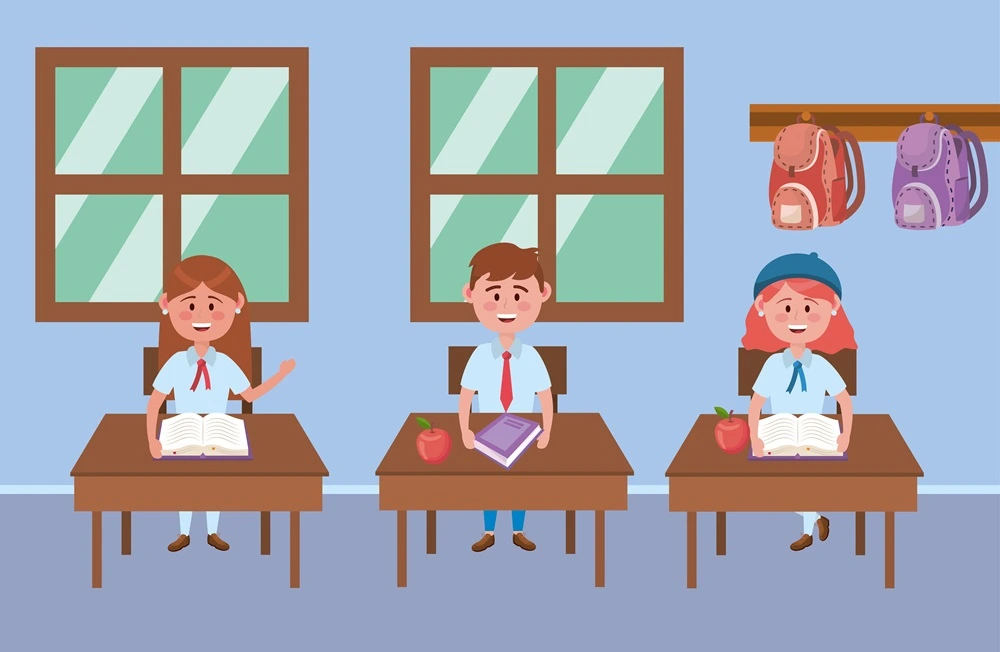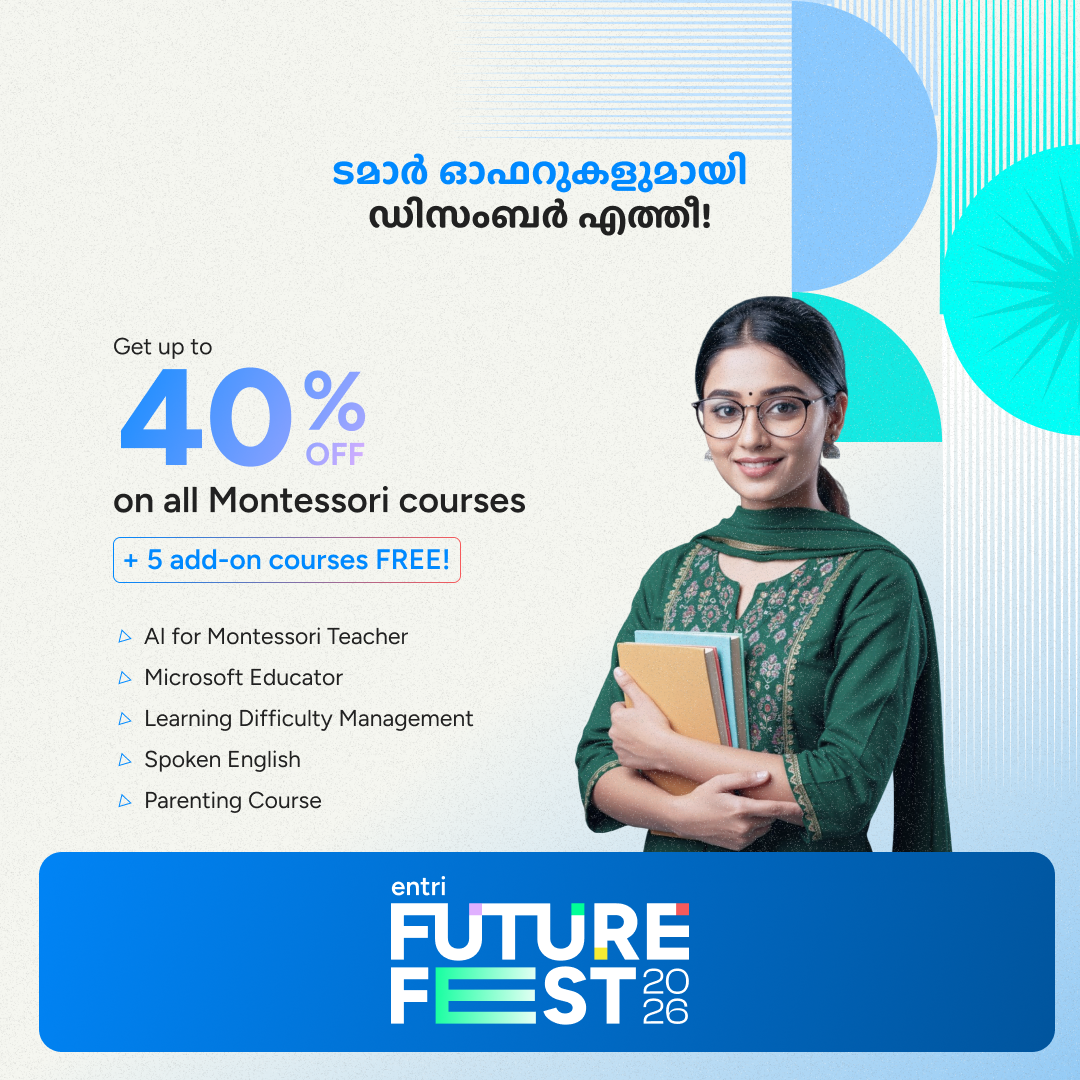Table of Contents
When it comes to selecting an educational approach for your child, one of the biggest decisions parents face is choosing between Montessori education and traditional schooling. Both systems aim to help children learn and grow, but their philosophies, methods, and learning environments differ significantly.
This blog post dives deep into the difference between Montessori and traditional education, so you can make an informed choice that suits your child’s learning style and future goals.
Montessori Education
Dr. Maria Montessori, an Italian physician and educator, created the Montessori educational technique in the early 20th century. The foundation of the Montessori approach is the idea that kids are inherently inquisitive and eager to learn, and that they flourish in settings that encourage self-reliance, experimentation, and introspection.
Key Features Of Montessori Education
1: What is the primary focus of the first plane of development in the Montessori method?
Independent learning, self-directed learning, and holistic development are all stressed in the distinctive Montessori educational approach to teaching and learning. The salient characteristics of Montessori education are as follows:
Multi-Age Classrooms: Students from several age groups usually attend Montessori classes. This configuration enables elder students to impart their knowledge to younger ones and enables younger students to learn from older classmates. Collaboration, empathy, and the development of social skills are further encouraged in mixed-age classrooms.
Child Centeerd Space: A Montessori classroom is a child-centered space that has been thoughtfully constructed to fulfill the developmental requirements of the students. A plethora of interactive educational resources and tasks that encourage investigation, finding, and self-directed learning are available to them. Based on their interests and skills, students can select activities from a variety of well-organized and easily available materials.
Self Directed Learning: Students in a Montessori classroom are allowed to investigate ideas and subjects at their own speed and in their own manner. As they support and encourage students in their self-directed learning activities, teachers act as facilitators and guides. This method encourages self-motivation, self-sufficiency, and a passion of learning that lasts a lifetime.
Sensory Based Learning: The Montessori approach places a strong emphasis on experiential, hands-on learning that appeals to the senses. Learning becomes a sensory-rich experience with Montessori materials since they are specifically made to appeal to children’s senses of touch, sight, sound, and movement. Children gain fine motor coordination, spatial awareness, and cognitive abilities through the manipulation and investigation of various objects.
Libeartion with boundaries: In addition to encouraging independence and freedom, Montessori education sets up boundaries and rules that children can easily comprehend and follow in order to show respect for their surroundings, peers, and resources. It is in a loving and caring setting that children learn to take responsibility for their actions, work through issues on their own, and become disciplined.
Personalized Instruction: Every child is an individual, and the Montessori education honors this fact. In order to adjust instruction, teachers evaluate each student’s interests, areas of strength, and areas for improvement. Through individualized instruction, students can follow their own interests and abilities while moving forward at their own speed.
Highlighting Practical Life skills: Developing useful life skills that kids may use in their daily lives is a major focus of the Montessori educational approach. In addition to fostering independence and self-confidence, tasks like pouring, sweeping, washing dishes, and getting dressed also help with fine and gross motor skills, concentration, and attention to detail.
Comprehensive Growth: The whole child’s development, intellectual, emotional, social, and physical, is the goal of Montessori education. Children grow into well-rounded people who can navigate the complexity of the world around them through a balanced curriculum that incorporates academics, the arts, real-world life skills, and outdoor activities.
In general, a Montessori education offers a loving and encouraging atmosphere that gives kids the tools they need to grow into self-assured, self-sufficient learners who are enthusiastic about discovering the world and giving back to society.
Start now to become a certified Montessori teacher! Get free Demo Here!
Get Certified & Start Your Montessori Career
Montessori Teacher Training Course by Entri App: Gain expert skills, earn certification, and kickstart your teaching career.
Join Now!Traditional Education
The term “traditional education” describes the traditional educational approach that has long been the norm in many regions of the world. It is distinguished by teacher-led instruction, standardized curricula, controlled classrooms, and evaluation techniques including grades and examinations.
Key Features Of Traditional Education
For many years, schools all throughout the world have employed the tried-and-true paradigm of traditional education, sometimes referred to as conventional education. Some of its salient characteristics are:
Teacher Centered Learning: The instructor is the main authority and source of knowledge in the classroom in conventional schooling. Students are required to pay attention, take notes, and obey directions as the teacher conducts classes, gives lectures, and leads discussions.
Systematic Curriculum: The curriculum in traditional education is structured around predetermined topics, subjects, and learning goals for every grade level. Education authorities or governing bodies frequently standardize and determine this curriculum.
Learning Through Textbooks: Textbooks, workbooks, and other instructional materials are largely used in traditional education to assist teaching and learning activities. Students can study and practice with structured content and exercises from these sites.
Standardised Evalutaion: In traditional education, assessments usually take the form of assignments, quizzes, exams, and standardized tests. These tests assign grades, monitor progress, and gauge students’ comprehension of the subject matter.
Classroom Organization: With the instructor at the front of the room and the students arranged in rows facing her, traditional classrooms frequently feature a hierarchical layout. Rules and classroom management strategies aid in preserving discipline and order.
Area of Expertise: An extensive range of disciplines, such as math, science, language arts, social studies, and physical education, are usually taught to children in traditional schooling. As they move up the grades, pupils might be able to explore specialist subjects or elective courses.
Assessment and Feedback Managed by Teachers: In traditional education, teachers are in charge of assessing students’ work, giving them feedback, and grading them according to their performance. Grades are used to convey students’ progress to parents, instructors, and administrators and act as a gauge of academic achievement.
Prioritizing memorization and repeating: Repetition of facts, formulas, and other information is frequently emphasized in traditional education through rote learning. Information from textbooks or presentations made by teachers should be retained and repeated by the students.
Standards and Regulations in the Classroom: Conventional education creates an organized learning environment by following predetermined guidelines, procedures, and expectations. It is required of students to respect authority figures, observe classroom rules, and meet deadlines.
Limitations Of Traditional Education
Traditional education has been criticized for potential shortcomings despite its lengthy history and broad use. These criticisms include:
One-size-fits-all approach: Students may become disengaged or frustrated by traditional education if it does not adapt to their varied learning styles, interests, and talents.
Reduced Critical Thinking and Creativity: The focus on standardized testing and curriculum may put rote memory ahead of creativity, critical thinking, and problem-solving skills.
Teacher-Centered Learning: Since teacher leadership is the primary mode of instruction in traditional classrooms, students may have fewer opportunities for collaboration, active engagement, and inquiry-based learning.
In many educational systems, traditional education is still the predominant model despite these criticisms, despite growing awareness of the need for innovation and educational reform to better serve the requirements of varied learners in the twenty-first century.
Achieve your dream of becoming a teacher! Join Montessori Course Now!
Get Certified & Start Your Montessori Career
Montessori Teacher Training Course by Entri App: Gain expert skills, earn certification, and kickstart your teaching career.
Join Now!Difference Between Montessori And Traditional Education
Montessori Education |
Traditional Education |
| Centered on promoting human development in its natural state | On the basis of implementing a national curriculum |
| Childrensfollow their own interests and learn at their own speed. | Childrens follow a predetermined curriculum and follow the same schedule for learning |
| They use resources that have been carefully developed for the goal of self-education. | Children are taught by the teacher |
| Child is an active participant in learning | Teachers instruct the students. |
| Knowledge is gained through the child’s personal interactions with the materials and the encouragement of their independence. | Learning is restricted to what is provided and is dependent on subjects. |
| The foundation of learning is the connection between physical exploration and intellect. | Children study at desks using worksheets and a whiteboard. |
| Child is free to work in an area that suits him or her, walk about, and speak whenever they want without bothering others. | Typically, during group sessions, children are given their own chair and are urged to sit still and pay attention. |
| Together with the students, the teacher works | The teacher is in charge of the class. |
| The child’s unique development provides motivation in and of itself. | Reward and punishment schemes are used to motivate people. |
| The setting and approach promote internal self-control. The main person who enforces external discipline is the teacher. | The main person who enforces external discipline is the teacher. |
| Child works on a chosen project for as long as they like. | Usually, a child is given a set amount of time to work. |
| Continuous work cycles | Block time, period lessons |
| Mixed age ranges | Similar age ranges |
| Learning and working in accordance with the child’s social development | Working and studying without considering the child’s social development |
| Mutual focus on the growth of one’s mind, body, emotions, and soult | Focus on intellectual growth |
| Common emphasis on acquiring social, academic, practical, and life | competencies emphasis on academics |
Pros And Cons Of Montessori Education
The Montessori educational approach is based on the idea that kids learn best when they are allowed to go at their own pace and in their own way. To help them with this, Montessori preschools let kids explore a variety of educational activities and toys at their own pace in an unstructured way. Three-year-olds make up each class so that older and younger students can benefit from each other’s knowledge. For your children, a Montessori education can be the best option for a primary education. It can be difficult to choose an educational philosophy, but it is important to take all aspects into account. Consider the following pros and cons of Montessori education to get you started:
Pros |
Cons |
| Comprehensive Method | Limited applicability |
| Individualized instruction | Lack of standardisation |
| Focus on life skills | Time and resources |
| Hands -on- materials | Limited professional development |
| Child centered learning | Resistance to change |
| community engagement | Assessment challenge |
Pros And Cons Of Traditional Education
Many people continue to use the antiquated traditional schooling system, which is still widely used today. Conventional schooling assembles students at a certain location and time under one roof. Teacher-driven instruction is the hallmark of traditional education. After class, the students can talk to the teacher to get their questions answered or they can debate them with their peers. The learner’s knowledge is contingent upon the instructor’s knowledge. Now let’s discuss the pros and cons of traditional education.
Pros |
Cons |
| Structured curriculum | Limited flexibility |
| Established standards | Resistance to change |
| Practical experience | Theoretical emphasis |
| Resource availability | One size fits all approach |
| Recognition and acceptance | Disconnect from classroom reality |
| Focus on pedagogy | High cost |
Which Is Better: Montessori or Traditional?
There is no universal answer. Each system offers benefits depending on the child’s personality, the family’s values, and long-term educational goals.
Montessori May Be Better If:
-
Your child is naturally curious and independent
-
You want holistic growth, not just academics
-
You prefer less pressure from homework and exams
-
You value real-world problem-solving skills
Traditional Education May Be Better If:
-
Your child thrives in structured settings
-
You want consistency and academic rigour
-
Your goal is competitive exam preparation
-
You prefer predictable routines
Final Thoughts
Understanding the difference between Montessori and traditional education is key to making an informed choice. While both models aim to educate and empower children, they do so through vastly different means.
Choose the one that aligns with:
-
Your child’s learning style
-
Your parenting philosophy
-
Your long-term educational vision
Remember: the best education isn’t always the most popular one, it’s the one that helps your child become a confident, curious, and capable learner.
Get Certified & Start Your Montessori Career
Montessori Teacher Training Course by Entri App: Gain expert skills, earn certification, and kickstart your teaching career.
Join Now!Frequently Asked Questions
What is the main difference between Montessori and traditional education?
The primary difference lies in the teaching approach. Montessori focuses on child-led, experiential learning, while traditional education relies on teacher-directed instruction and structured curriculum.
Is Montessori education suitable for every child?
Montessori can benefit many children, especially those who are independent, curious, and self-motivated. However, some children may thrive better in a structured traditional setting depending on their personality and learning needs.
How do Montessori classrooms manage mixed-age groups?
Montessori classrooms typically group children in 3-year age spans (e.g., 3–6 years), encouraging peer learning, mentoring, and social development, which is not common in traditional systems.
Are there exams and grades in Montessori schools?
No, Montessori schools generally use continuous observation and portfolio assessments rather than traditional tests and grades. This approach focuses on holistic development, not just academic scores.
Do Montessori students transition well to traditional schools later?
Yes, many do. Montessori students often develop strong problem-solving, time management, and self-regulation skills, which help them adapt well to traditional environments if needed.
Which method is more recognised worldwide, Montessori or traditional?
Traditional education is more widely recognised, especially in public school systems. Montessori is respected globally but might require additional adjustments when transferring between systems.
Is Montessori more expensive than traditional education?
Generally, yes. Montessori schools often have higher tuition fees due to low student-teacher ratios and specialised materials. However, value lies in the child-centred approach and holistic development.
What role do parents play in each system?
In Montessori, parent involvement is highly encouraged through regular communication, home support, and community events. In traditional systems, parent engagement varies based on the school.
Which system is better for preparing children for competitive exams?
Traditional education may be more suitable for competitive exam readiness, as it follows a structured syllabus with regular testing and exam strategies.
Can Montessori methods be combined with traditional schooling?
Yes, many progressive schools now blend Montessori principles with traditional curriculum, offering a hybrid approach that balances structure with creativity and independence.













